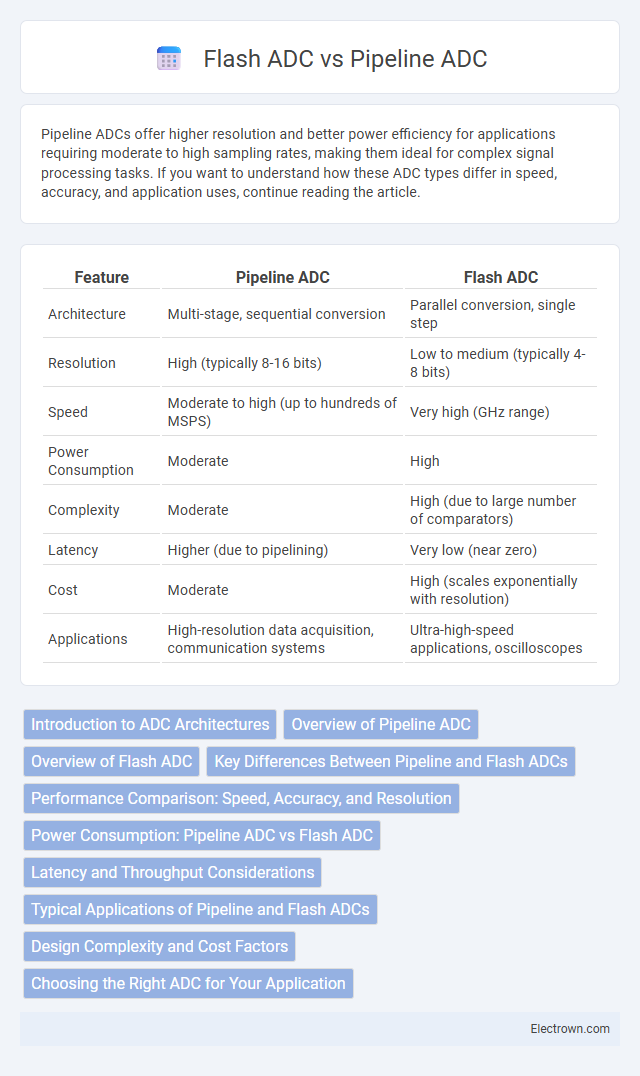Pipeline ADCs offer higher resolution and better power efficiency for applications requiring moderate to high sampling rates, making them ideal for complex signal processing tasks. If you want to understand how these ADC types differ in speed, accuracy, and application uses, continue reading the article.
Table of Comparison
| Feature | Pipeline ADC | Flash ADC |
|---|---|---|
| Architecture | Multi-stage, sequential conversion | Parallel conversion, single step |
| Resolution | High (typically 8-16 bits) | Low to medium (typically 4-8 bits) |
| Speed | Moderate to high (up to hundreds of MSPS) | Very high (GHz range) |
| Power Consumption | Moderate | High |
| Complexity | Moderate | High (due to large number of comparators) |
| Latency | Higher (due to pipelining) | Very low (near zero) |
| Cost | Moderate | High (scales exponentially with resolution) |
| Applications | High-resolution data acquisition, communication systems | Ultra-high-speed applications, oscilloscopes |
Introduction to ADC Architectures
Pipeline ADCs employ a sequential conversion process with multiple stages, balancing speed and resolution by dividing the analog input into smaller bits for each step, making them suitable for high-resolution applications. Flash ADCs use a parallel architecture with a large bank of comparators, offering the fastest conversion speeds but with high power consumption and complexity, ideal for ultra-high-speed scenarios. Your choice between these architectures depends on the required trade-off between speed, resolution, and power efficiency for the specific application.
Overview of Pipeline ADC
Pipeline ADCs offer a balanced trade-off between speed and resolution by breaking down the analog-to-digital conversion process into several stages, each performing a portion of the conversion. These converters typically achieve moderate to high sampling rates with resolutions ranging from 8 to 16 bits, making them suitable for applications like digital oscilloscopes and communication systems. Your choice of a Pipeline ADC benefits from lower power consumption and reduced input capacitance compared to Flash ADCs, especially in medium-to-high resolution scenarios.
Overview of Flash ADC
Flash ADCs offer the fastest conversion speeds among analog-to-digital converters by utilizing a parallel array of comparators to simultaneously compare the input voltage against reference levels. This architecture enables ultra-high sampling rates, making it ideal for applications requiring real-time data processing. Your choice of Flash ADC ensures minimal latency but comes with increased power consumption and complexity, especially as resolution increases.
Key Differences Between Pipeline and Flash ADCs
Pipeline ADCs offer higher resolution and moderate speed, making them ideal for applications requiring accurate digital conversion in the range of 8 to 16 bits. Flash ADCs provide ultra-high-speed conversion with typically lower resolution, often 4 to 6 bits, by using a large number of comparators for parallel processing. The key differences lie in their architectures: pipeline ADCs use a staged approach with sample-and-hold circuits and residue amplification, while flash ADCs rely on simultaneous comparison, resulting in trade-offs between speed, complexity, power consumption, and resolution.
Performance Comparison: Speed, Accuracy, and Resolution
Pipeline ADCs provide high resolution typically ranging from 10 to 16 bits, delivering better accuracy and moderate speed up to several hundred megasamples per second (MSPS). Flash ADCs excel in speed, offering conversion rates in the gigasamples per second (GSPS) range, but they trade off resolution, usually limited to 6 to 8 bits, resulting in lower accuracy for high-precision applications. The choice hinges on balancing speed demands against resolution requirements, with pipeline ADCs favored for accurate signal conversion and flash ADCs preferred for ultra-high-speed, lower-resolution tasks.
Power Consumption: Pipeline ADC vs Flash ADC
Pipeline ADCs offer significantly lower power consumption compared to Flash ADCs, making them more suitable for high-resolution and moderate-speed applications where energy efficiency is crucial. Flash ADCs consume substantially more power due to their parallel architecture, requiring 2^n - 1 comparators for an n-bit resolution, leading to exponential growth in power usage with increased resolution. The efficient power management in Pipeline ADCs supports extended battery life in portable devices, while the Flash ADC's higher power requirements limit its use to very high-speed, lower-resolution scenarios.
Latency and Throughput Considerations
Pipeline ADCs offer lower latency due to their sequential stage processing, making them suitable for applications requiring real-time data conversion with minimal delay. Flash ADCs provide higher throughput by converting the input signal simultaneously across all comparators, ideal for ultra-high-speed operations but often at the expense of increased power consumption and complexity. Choosing between the two depends on balancing your need for speed versus system latency in your specific application.
Typical Applications of Pipeline and Flash ADCs
Pipeline ADCs are commonly used in applications requiring high resolution and moderate to high sampling rates, such as digital oscilloscopes, radar systems, and high-speed data acquisition. Flash ADCs excel in ultra-high-speed applications like video and graphics processing, communication receivers, and real-time signal analysis due to their low latency and high throughput. Both ADC types serve critical roles in mixed-signal processing, with pipeline ADCs balancing speed and accuracy, while flash ADCs prioritize speed at the cost of resolution.
Design Complexity and Cost Factors
Pipeline ADCs exhibit moderate design complexity with multi-stage amplification and sample-and-hold circuits, making them more cost-effective for high-resolution applications compared to Flash ADCs. Flash ADCs, characterized by a large number of comparators and high-speed operation, have significantly higher design complexity and manufacturing costs, especially as resolution increases beyond 6 bits. Your choice depends on balancing the required speed, resolution, and budget constraints for the specific application.
Choosing the Right ADC for Your Application
Pipeline ADCs offer high resolution and moderate speed, making them ideal for applications like audio processing and instrumentation where accuracy is critical. Flash ADCs deliver ultra-fast conversion rates with lower resolution, suited for applications such as radar and high-speed data acquisition. Selecting between Pipeline and Flash ADCs depends on balancing factors like sampling rate, resolution, power consumption, and application-specific requirements.
Pipeline ADC vs Flash ADC Infographic

 electrown.com
electrown.com